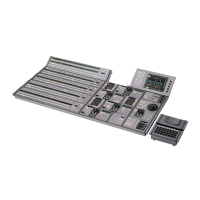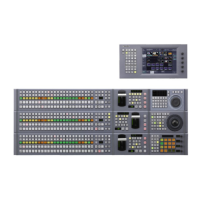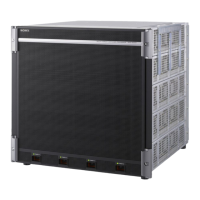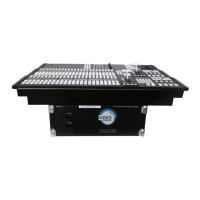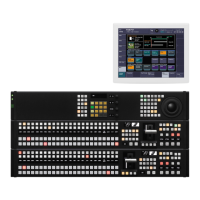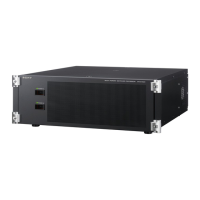Using a DME currently used on another
keyer
[OVERRIDE] button: When one DME channel is in use,
holding down this button and pressing a DME channel
button ([DME1] to [DME8]) allows you to forcibly
select this channel. The button for the selected DME
channel lights green.
Recalling the keyer using the DME channel
[TRCE] button: Holding down this button, press the
selection button for the DME channel already assigned
to another keyer or transition, to switch the keyer or
transition to which the DME channel is assigned to the
currently selected state.
Monitoring DME output
[DME MON] button: Holding down this button and
pressing the selection button for a DME channel
([DME1] to [DME8]) allows you to monitor the signal
for this channel as a reentry signal to DME MON V/K.
However, it is first necessary to assign this channel on
the DME to the delegation (keyer or transition) to be
monitored.
Selecting the DME channel
[DME1] to [DME8] buttons: Press one of these to select
the corresponding DME channel. The number of valid
buttons depends on the number of DME channels in
use.
[DME MORE] button: If there are more than four DME
channels in use, use this to change the DME channel
selection buttons displayed.
Returning the key adjustment values to
their defaults
Holding down a key type button ([LUM], [LIN], [CRK], or
[WIPE PTN]) recalls the key default values.
Key modify clear
When the [KEY ADJ] button is held down, holding down
the region selection button for the selected region together
returns all the key settings of the region to the initial status
settings.
When the [KEY ADJ] button is held down, holding down
the button for the selected key together returns the key
settings to the initial status settings.
For details of the initial status, see “Saving User-Defined
Settings” in Chapter 18 (Volume 2).
Resizer
Resizer allows you to apply DME-like effects such as
image shrinking, magnification and movement, rotation as
well as change of the aspect ratio, to the processed key.
The following functions are available.
•
Two-dimensional transformations of keys (page 152)
•
Key rotation around the X- or Y-axis
•
Resizer interpolation settings (page 155)
•
Resizer crop/border settings (page 155)
•
Resizer effect settings (page 156)
(wide key border, drop shadow, edge enhance, mosaic,
defocus, mask)
Notes
•
The image of the key manipulated by resizer has a one-
frame delay.
•
Some effects of resizer are different from what you
would expect of DME effects.
Restrictions on the use of effects
There are restrictions on combined use of resizer effects
themselves and that with DME wipes.
For details, see “Impossibility of simultaneous use within
the same keyer” (page 159).
Relation between resizer and other effects
You cannot apply DME effects to a key for which the
resizer function is enabled. When one of the three
functions – resizer, DME wipe and DME effects – is
enabled, the other two are disabled.
Two-Dimensional Transformations
and Rotation of Keys
Notes
When the screen aspect ratio is 4:3 in HD format, when the
resizer is used to shrink a video image, this is applied to the
16:9 screen including the added video on the left and right
sides. Use the crop function as required to extract the 4:3
image.
Menu operations for key shrinking,
magnification, rotation and movement
For example, to shrink, magnify, rotate or move key 1 of
the M/E-1 bank, use the following procedure.
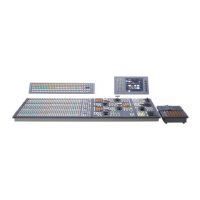
